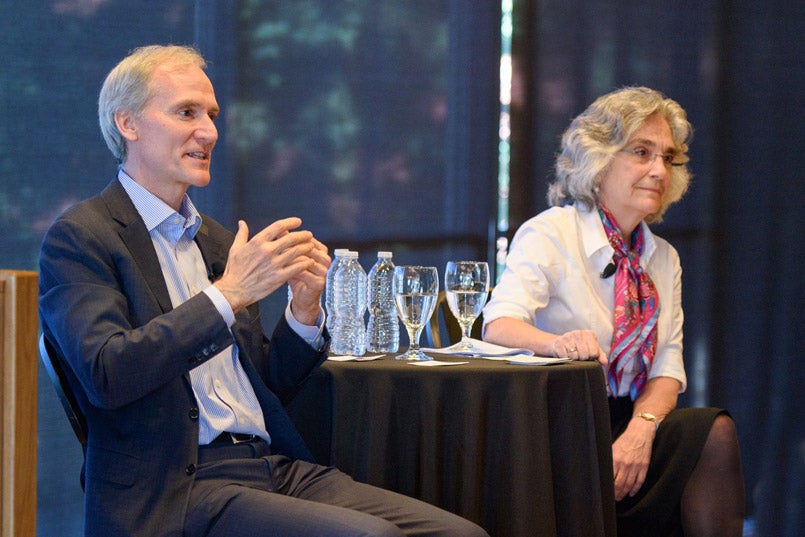January 29, 2018
Hoop Dreams: thoughts on diversifying our faculty
Recently I met with Jennifer Widom, dean of the School of Engineering; Stacey Bent, the senior associate dean of engineering; and legendary Stanford women’s basketball coach Tara VanDerveer at the Faculty Club. The topic was the challenge of improving faculty diversity at Stanford.
Invariably the conversation turned to Tara’s impressive track record of success in her 32 years at Stanford. More than 1,000 wins, two NCAA Championships, 12 NCAA Final Four appearances, 22 Pac-12 regular-season titles, 12 Pac-12 Tournament crowns, 29 trips to the NCAA Tournament, and two James Naismith National Player of the Year Award winners. Simply amazing. How did she do it? What’s her secret?
Of course, there are many reasons for her success: her talent and leadership skills, her strong connection and commitment to her players, and her ability to adapt to the changing nature of collegiate athletics. But, for me, what stands out is that she’s a brilliant recruiter.
Tara spoke of the strategies she and her coaches use to identify prospects years in advance and keep an eye on their development, all the while helping them (and their families) understand what it will take to get in to Stanford and then be successful once they are here. It’s more than finding talent. It’s about nurturing. And it’s about creating pathways to success as a student-athlete at Stanford.
That got the group of us thinking: how might we apply Tara’s successful recruitment strategies to increase diversity among our faculty population?
The diversity of our faculty is crucial to our mission. We depend upon diversity of thought, experience, and perspective, and a diverse student body must see a diverse faculty. Yet, despite many efforts, our faculty is 72 percent male and 71 percent non-minority (see Diversity Facts).
If we want to be an outstanding institution that attracts the best students and the best faculty now, and in the future, we have to do better in this area. Ultimately, diversifying the faculty is about the long-term viability of the institution.
Perhaps we need to change our way of thinking when we’re recruiting faculty. We discussed that sometimes there’s this feeling: “We are Stanford. We are the most desirable place for a faculty member in the country.” We should consider that perhaps that’s a little arrogant. And perhaps a little off-putting to some potential candidates.
Increasing diversity among the faculty at Stanford isn’t a new challenge. Over the years, the university has set broad policies, created programs, funded initiatives, and sponsored events focused on diversity and inclusion (see Diversity Works and Diversity and Access websites as well as Office of the Vice Provost for Faculty Development and Diversity.)
These efforts are welcomed and appreciated, but we need to do much more. We will not be in a position to attract the most outstanding faculty and students a decade from now if we cannot make faster progress today.
Ultimately the responsibility for hiring faculty falls on the academic departments. I do think there are some lessons we can all learn from Tara VanDerveer. Identify talent early. Nurture and support. Create pathways for success. Support people for success once they are here.
Perhaps we need to be more aggressive in recruiting the young assistant professors, particularly diverse candidates, that we want to have here. Let’s not sit back and wait for them to come to us.
And what about our future players? Recognizing that the graduate students and postdocs of today are the faculty members of tomorrow, what can we do to support a pipeline of students and postdocs who will bring diverse voices and experiences to the academy, not just at Stanford but throughout academia? The DARE Doctoral Fellowship Program, now in its 10th year, is one way we’re doing exactly that. Perhaps we should be considering a similar initiative at the postdoctoral level? And just as Tara supports her players to be successful at Stanford, we need to make sure that we are fully supporting our diverse faculty to be successful once they are here.
Increasing faculty diversity is an imperative that we must solve together as a community. It’s going to take time and it’s going to take commitment. I see a lot of possibilities, and there have been many good ideas coming through the long-range planning process that we can move forward on. I encourage deans, chairs, and faculty to share their thoughts and best practices—and maybe take some risks along the way. After all, you don’t get to 1,000 wins by sitting on the sidelines.
